Tesla Motors: Internal, External, Marketing, and Leadership Analysis
VerifiedAdded on 2022/08/14
|23
|2308
|12
Report
AI Summary
This report analyzes Tesla Motors from multiple perspectives, including internal factors like culture, human resources, and resource allocation, and external factors such as stakeholders and regulatory conditions. It delves into Tesla's marketing strategies, customer-related factors, and systems. The technology section examines Tesla's innovative culture and R&D teams, while the leadership component focuses on Elon Musk's transformational leadership, different experiences, and change capabilities. The report provides recommendations for each area, aiming to enhance Tesla's disruptive innovation and strategic leadership in the electric vehicle market. It emphasizes the importance of centralized structure, strategic alliances, innovation, and effective communication to address challenges and leverage opportunities for sustainable growth.
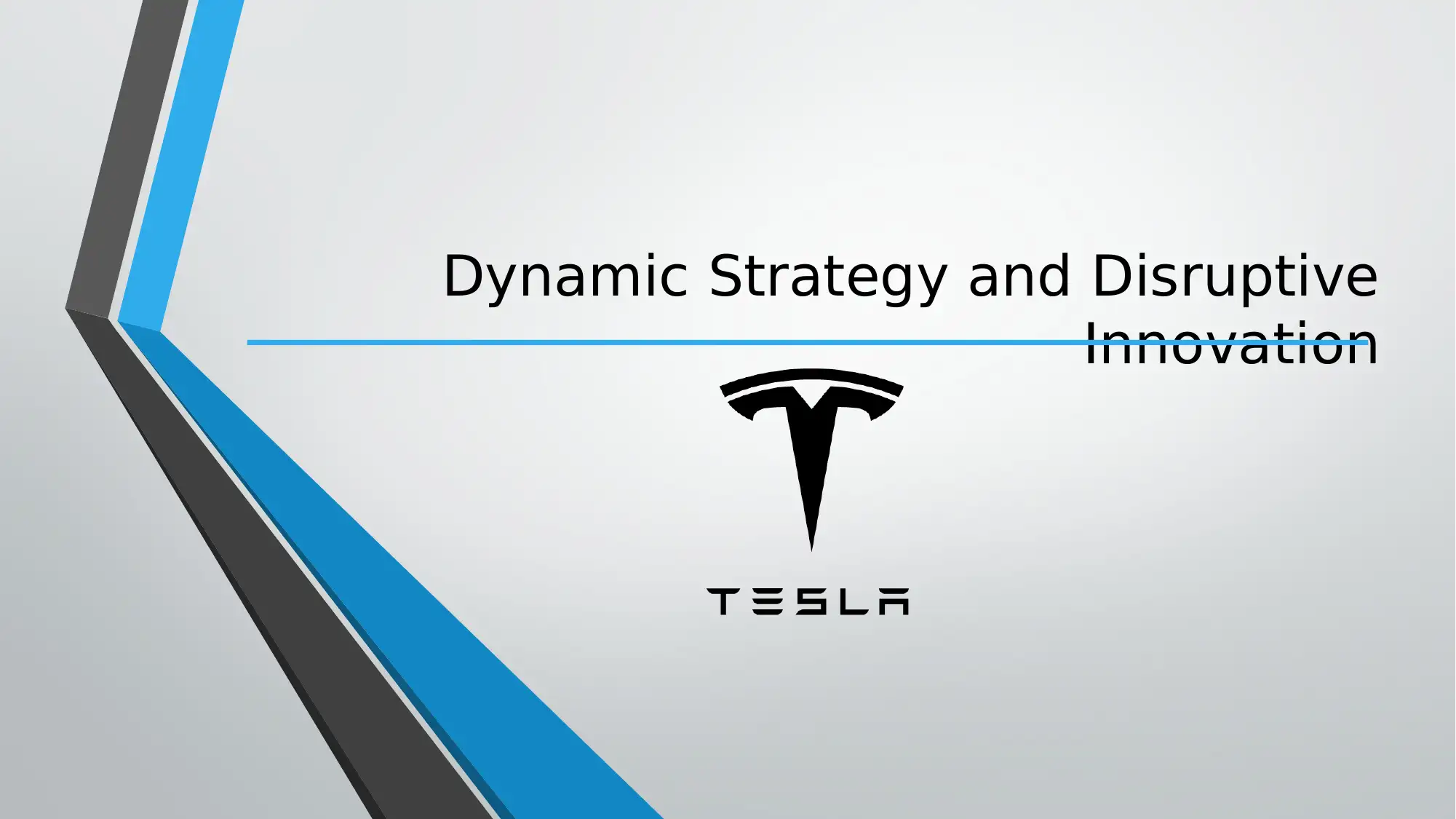
Dynamic Strategy and Disruptive
Innovation
Innovation
Paraphrase This Document
Need a fresh take? Get an instant paraphrase of this document with our AI Paraphraser
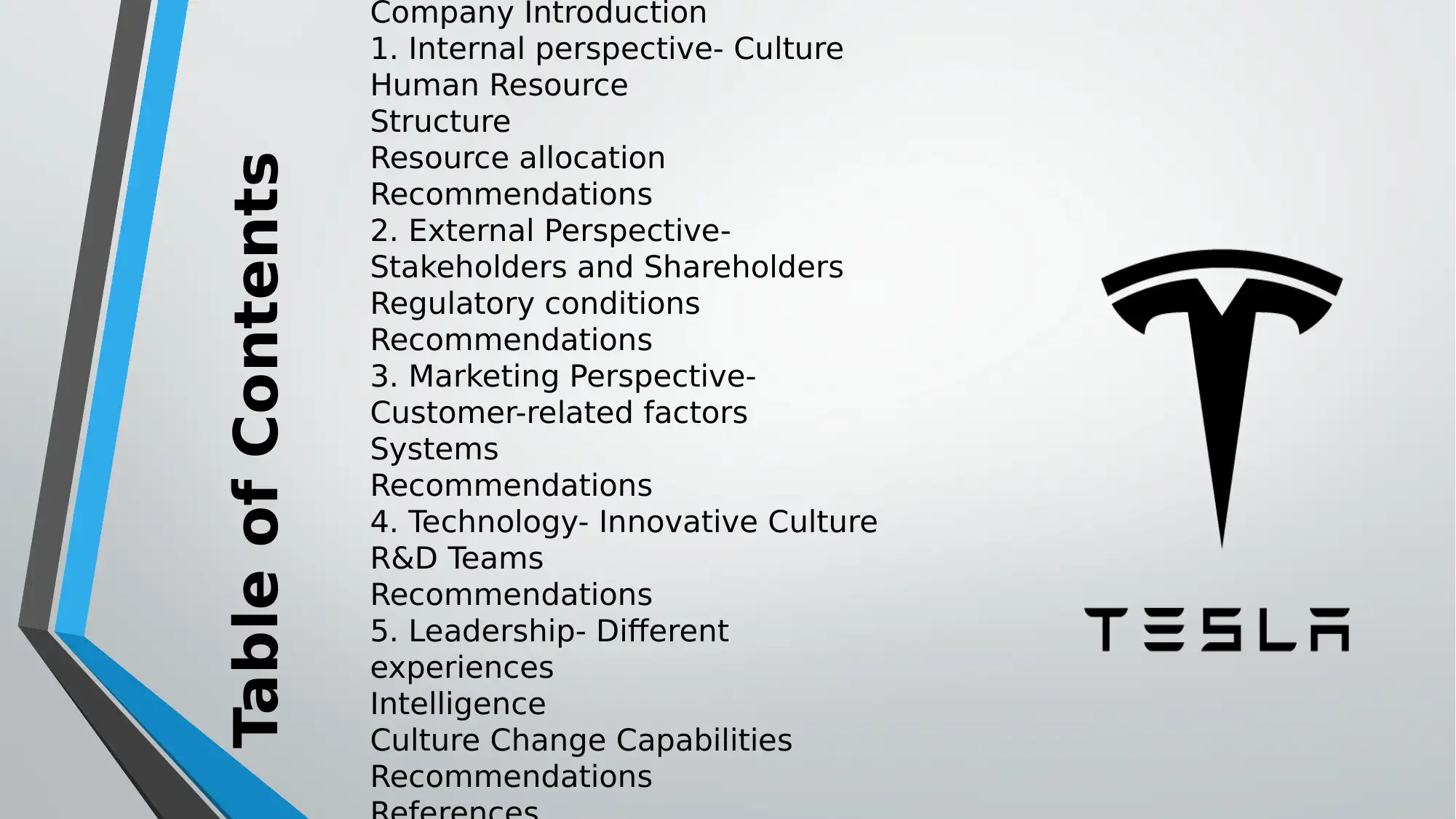
Company Introduction
1. Internal perspective- Culture
Human Resource
Structure
Resource allocation
Recommendations
2. External Perspective-
Stakeholders and Shareholders
Regulatory conditions
Recommendations
3. Marketing Perspective-
Customer-related factors
Systems
Recommendations
4. Technology- Innovative Culture
R&D Teams
Recommendations
5. Leadership- Different
experiences
Intelligence
Culture Change Capabilities
Recommendations
Table of Contents
1. Internal perspective- Culture
Human Resource
Structure
Resource allocation
Recommendations
2. External Perspective-
Stakeholders and Shareholders
Regulatory conditions
Recommendations
3. Marketing Perspective-
Customer-related factors
Systems
Recommendations
4. Technology- Innovative Culture
R&D Teams
Recommendations
5. Leadership- Different
experiences
Intelligence
Culture Change Capabilities
Recommendations
Table of Contents
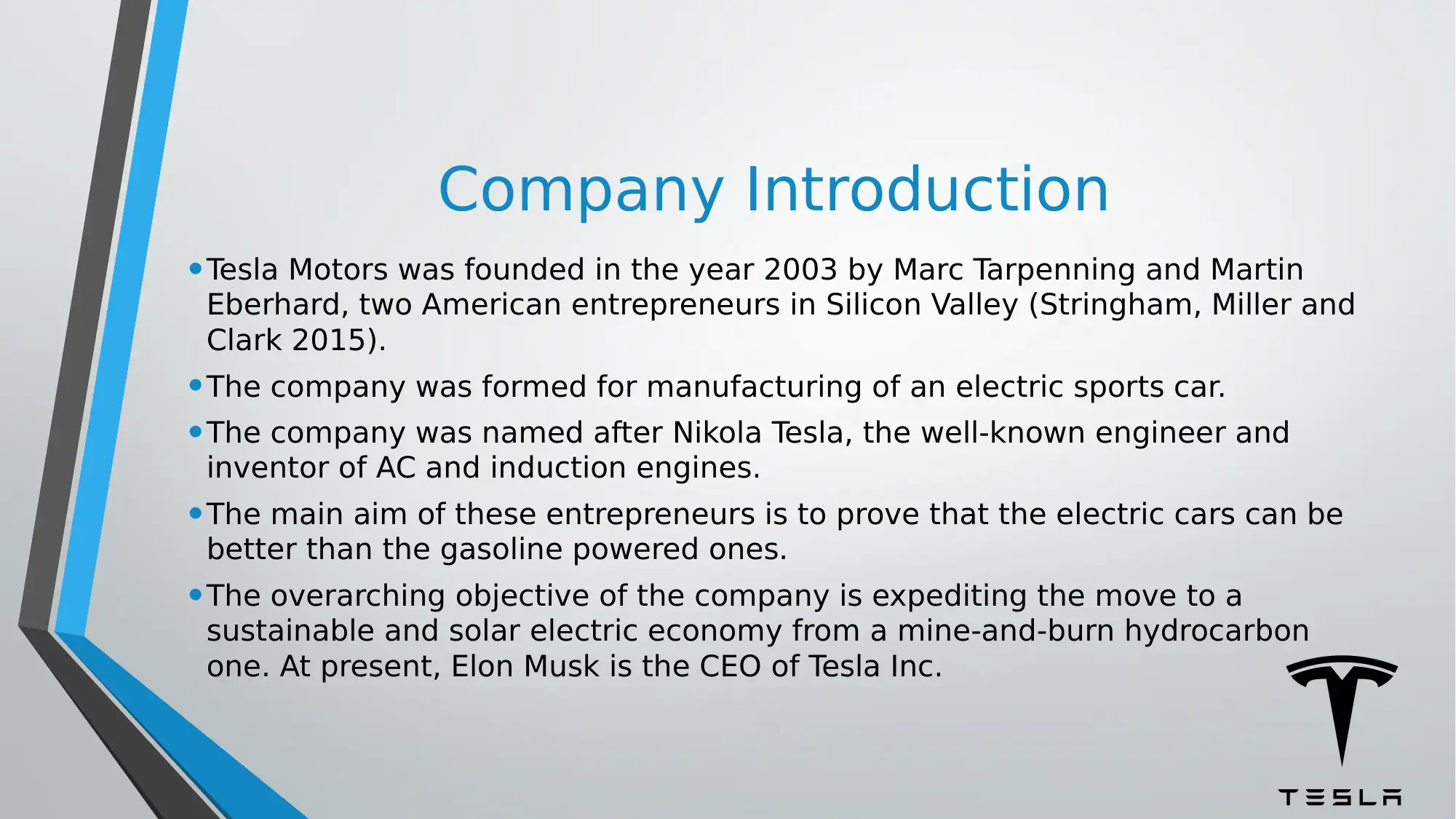
Company Introduction
•Tesla Motors was founded in the year 2003 by Marc Tarpenning and Martin
Eberhard, two American entrepreneurs in Silicon Valley (Stringham, Miller and
Clark 2015).
•The company was formed for manufacturing of an electric sports car.
•The company was named after Nikola Tesla, the well-known engineer and
inventor of AC and induction engines.
•The main aim of these entrepreneurs is to prove that the electric cars can be
better than the gasoline powered ones.
•The overarching objective of the company is expediting the move to a
sustainable and solar electric economy from a mine-and-burn hydrocarbon
one. At present, Elon Musk is the CEO of Tesla Inc.
•Tesla Motors was founded in the year 2003 by Marc Tarpenning and Martin
Eberhard, two American entrepreneurs in Silicon Valley (Stringham, Miller and
Clark 2015).
•The company was formed for manufacturing of an electric sports car.
•The company was named after Nikola Tesla, the well-known engineer and
inventor of AC and induction engines.
•The main aim of these entrepreneurs is to prove that the electric cars can be
better than the gasoline powered ones.
•The overarching objective of the company is expediting the move to a
sustainable and solar electric economy from a mine-and-burn hydrocarbon
one. At present, Elon Musk is the CEO of Tesla Inc.
⊘ This is a preview!⊘
Do you want full access?
Subscribe today to unlock all pages.

Trusted by 1+ million students worldwide
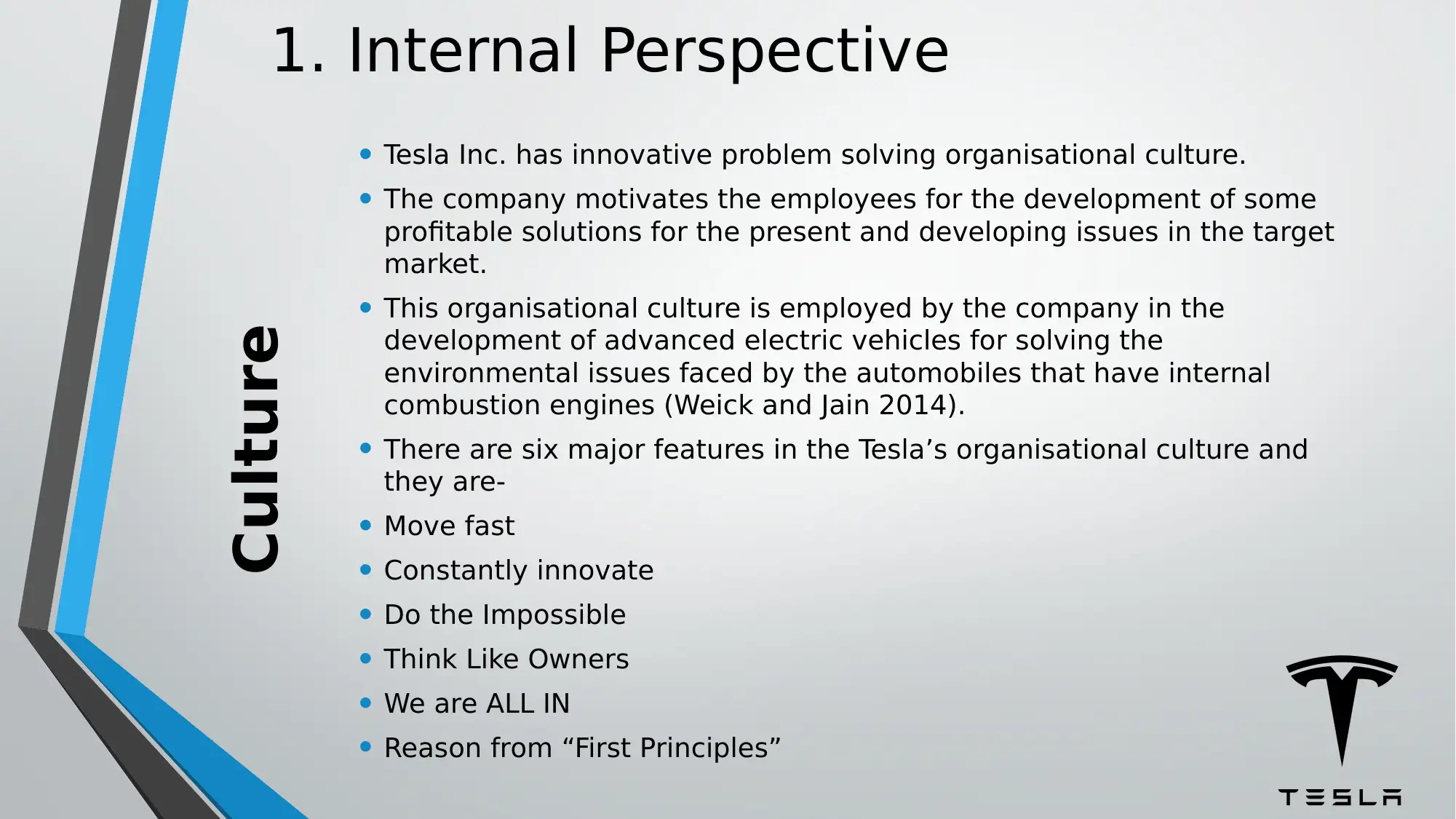
1. Internal Perspective
Culture
• Tesla Inc. has innovative problem solving organisational culture.
• The company motivates the employees for the development of some
profitable solutions for the present and developing issues in the target
market.
• This organisational culture is employed by the company in the
development of advanced electric vehicles for solving the
environmental issues faced by the automobiles that have internal
combustion engines (Weick and Jain 2014).
• There are six major features in the Tesla’s organisational culture and
they are-
• Move fast
• Constantly innovate
• Do the Impossible
• Think Like Owners
• We are ALL IN
• Reason from “First Principles”
Culture
• Tesla Inc. has innovative problem solving organisational culture.
• The company motivates the employees for the development of some
profitable solutions for the present and developing issues in the target
market.
• This organisational culture is employed by the company in the
development of advanced electric vehicles for solving the
environmental issues faced by the automobiles that have internal
combustion engines (Weick and Jain 2014).
• There are six major features in the Tesla’s organisational culture and
they are-
• Move fast
• Constantly innovate
• Do the Impossible
• Think Like Owners
• We are ALL IN
• Reason from “First Principles”
Paraphrase This Document
Need a fresh take? Get an instant paraphrase of this document with our AI Paraphraser
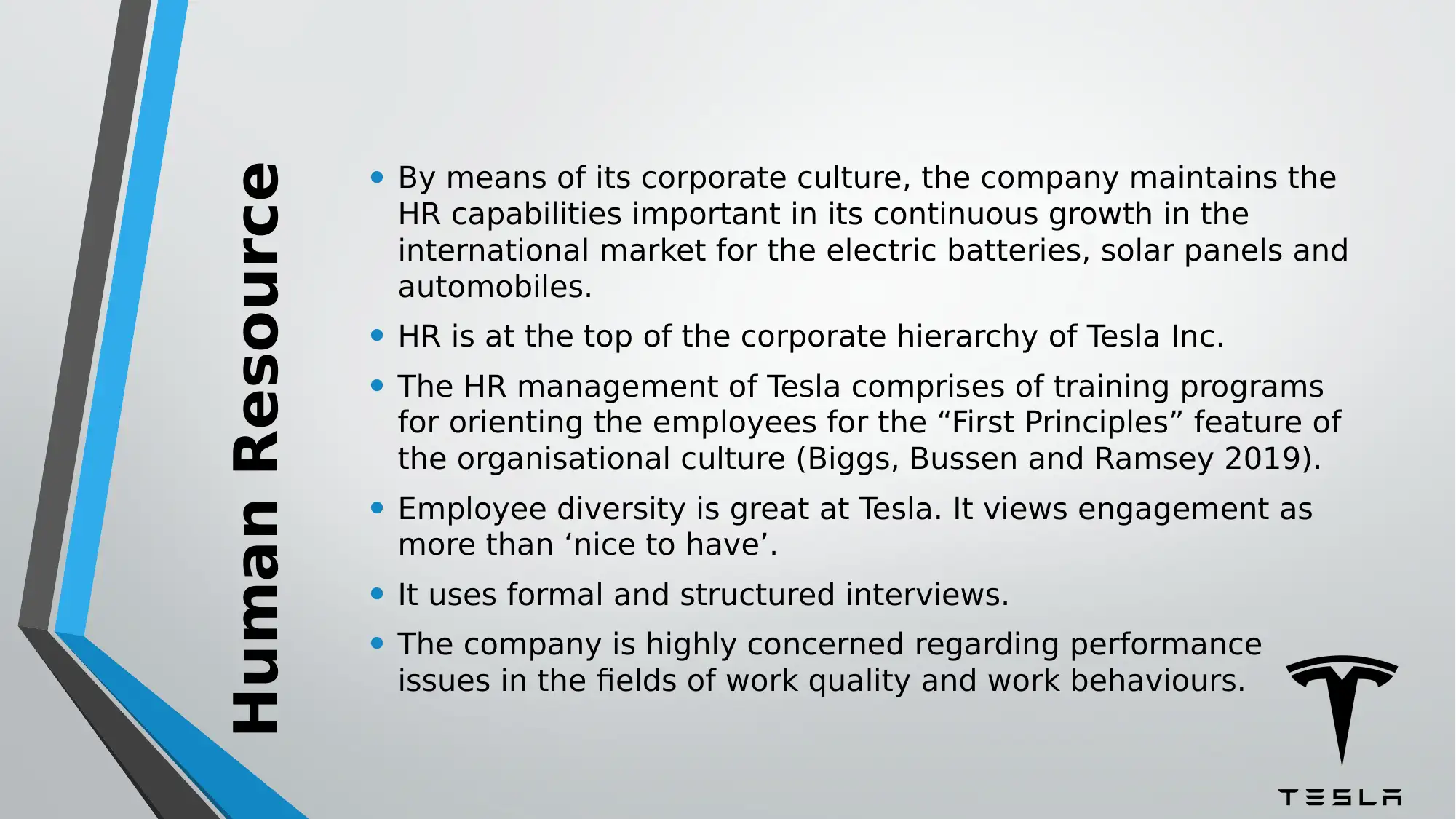
• By means of its corporate culture, the company maintains the
HR capabilities important in its continuous growth in the
international market for the electric batteries, solar panels and
automobiles.
• HR is at the top of the corporate hierarchy of Tesla Inc.
• The HR management of Tesla comprises of training programs
for orienting the employees for the “First Principles” feature of
the organisational culture (Biggs, Bussen and Ramsey 2019).
• Employee diversity is great at Tesla. It views engagement as
more than ‘nice to have’.
• It uses formal and structured interviews.
• The company is highly concerned regarding performance
issues in the fields of work quality and work behaviours.
Human Resource
HR capabilities important in its continuous growth in the
international market for the electric batteries, solar panels and
automobiles.
• HR is at the top of the corporate hierarchy of Tesla Inc.
• The HR management of Tesla comprises of training programs
for orienting the employees for the “First Principles” feature of
the organisational culture (Biggs, Bussen and Ramsey 2019).
• Employee diversity is great at Tesla. It views engagement as
more than ‘nice to have’.
• It uses formal and structured interviews.
• The company is highly concerned regarding performance
issues in the fields of work quality and work behaviours.
Human Resource
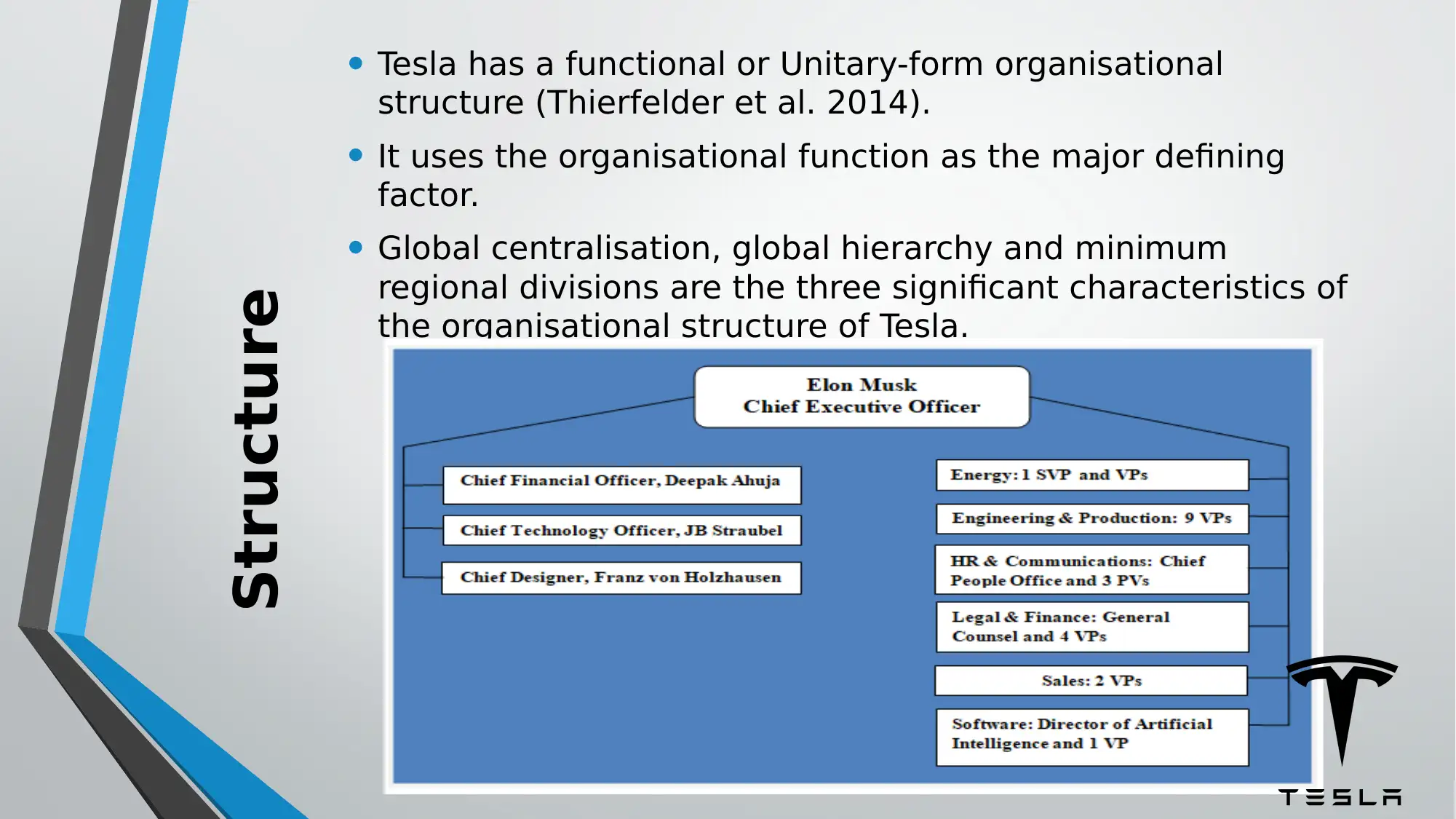
• Tesla has a functional or Unitary-form organisational
structure (Thierfelder et al. 2014).
• It uses the organisational function as the major defining
factor.
• Global centralisation, global hierarchy and minimum
regional divisions are the three significant characteristics of
the organisational structure of Tesla.
Structure
structure (Thierfelder et al. 2014).
• It uses the organisational function as the major defining
factor.
• Global centralisation, global hierarchy and minimum
regional divisions are the three significant characteristics of
the organisational structure of Tesla.
Structure
⊘ This is a preview!⊘
Do you want full access?
Subscribe today to unlock all pages.

Trusted by 1+ million students worldwide
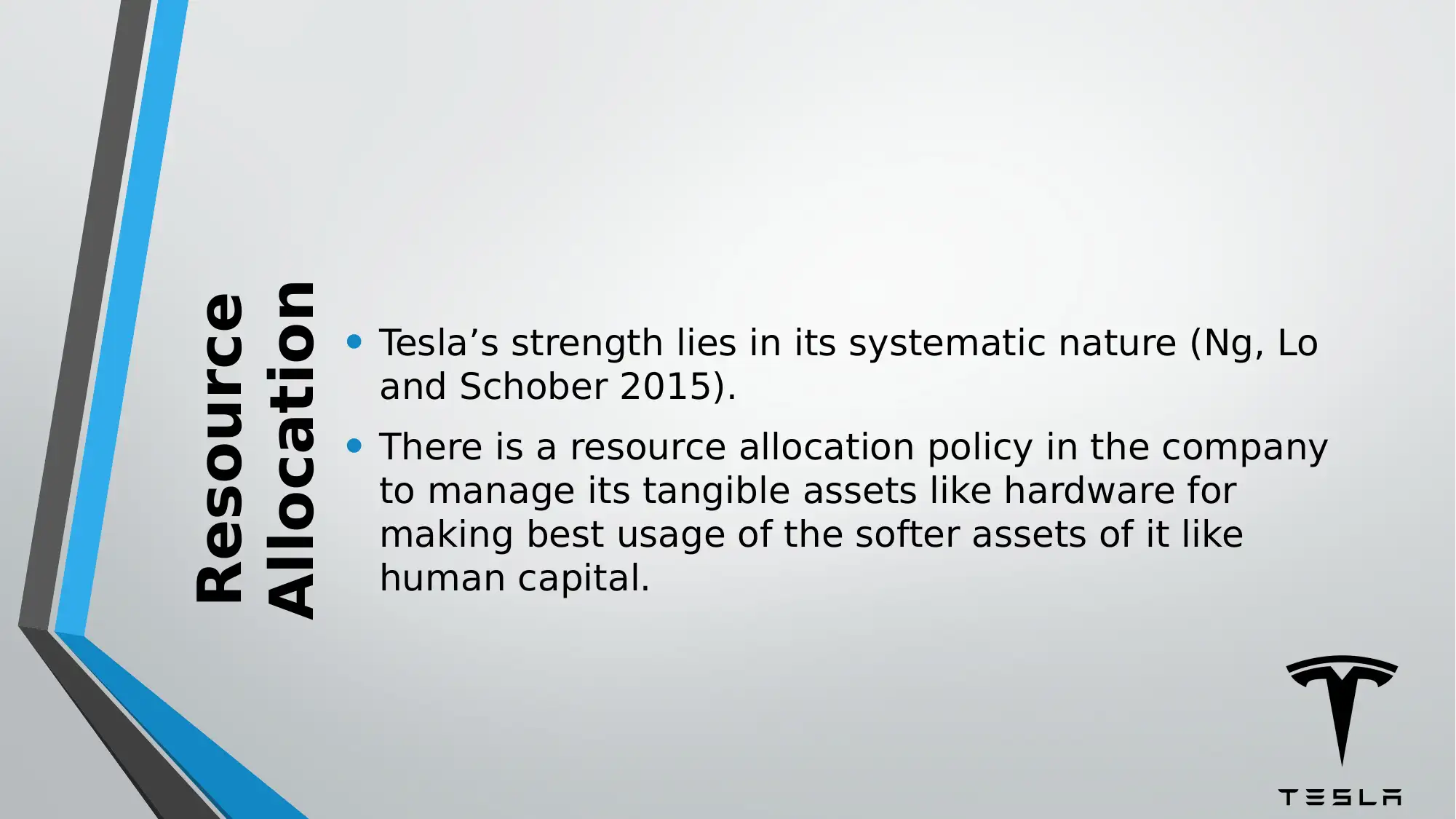
• Tesla’s strength lies in its systematic nature (Ng, Lo
and Schober 2015).
• There is a resource allocation policy in the company
to manage its tangible assets like hardware for
making best usage of the softer assets of it like
human capital.
Resource
Allocation
and Schober 2015).
• There is a resource allocation policy in the company
to manage its tangible assets like hardware for
making best usage of the softer assets of it like
human capital.
Resource
Allocation
Paraphrase This Document
Need a fresh take? Get an instant paraphrase of this document with our AI Paraphraser
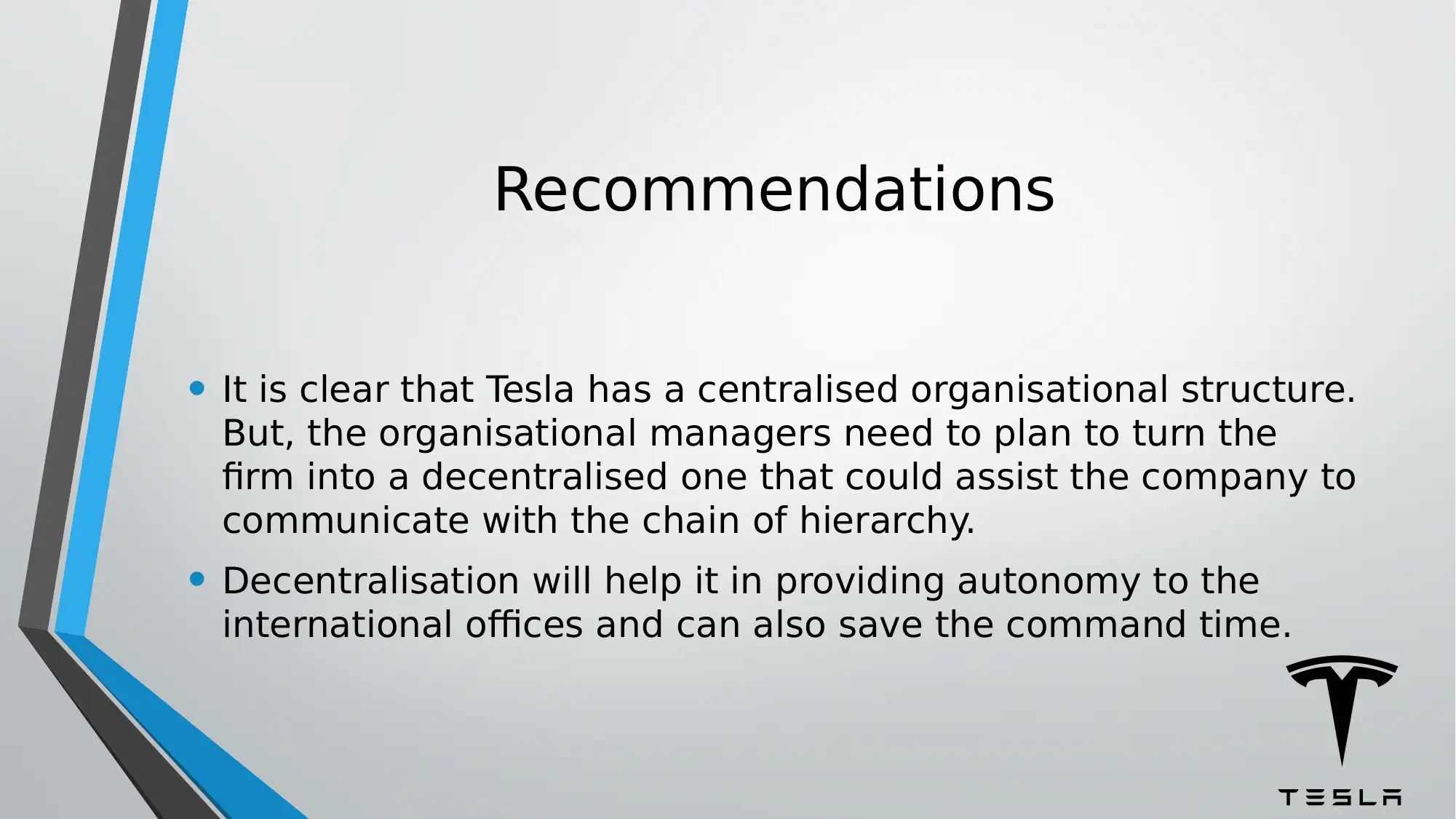
Recommendations
• It is clear that Tesla has a centralised organisational structure.
But, the organisational managers need to plan to turn the
firm into a decentralised one that could assist the company to
communicate with the chain of hierarchy.
• Decentralisation will help it in providing autonomy to the
international offices and can also save the command time.
• It is clear that Tesla has a centralised organisational structure.
But, the organisational managers need to plan to turn the
firm into a decentralised one that could assist the company to
communicate with the chain of hierarchy.
• Decentralisation will help it in providing autonomy to the
international offices and can also save the command time.
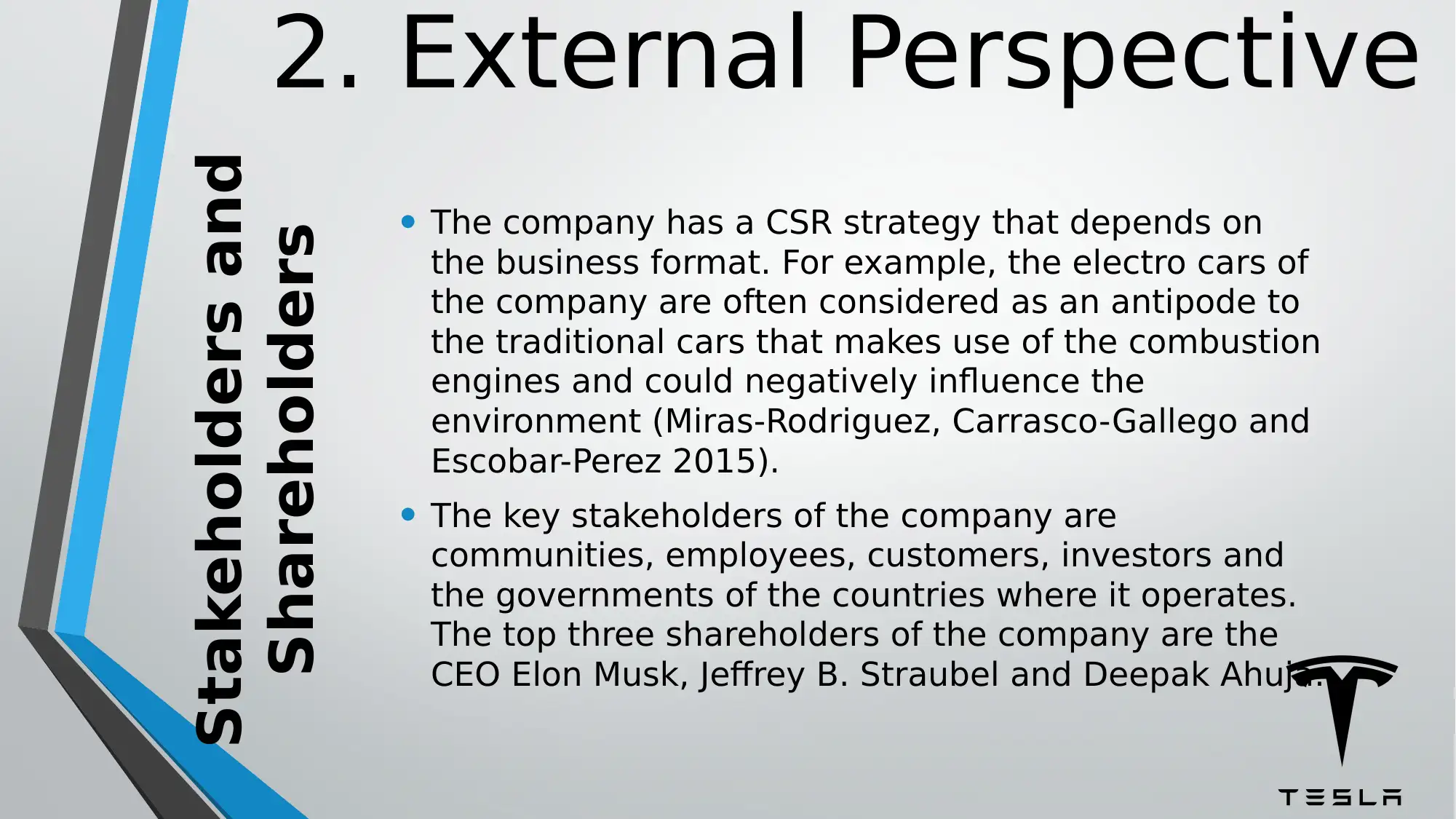
2. External Perspective
• The company has a CSR strategy that depends on
the business format. For example, the electro cars of
the company are often considered as an antipode to
the traditional cars that makes use of the combustion
engines and could negatively influence the
environment (Miras-Rodriguez, Carrasco-Gallego and
Escobar-Perez 2015).
• The key stakeholders of the company are
communities, employees, customers, investors and
the governments of the countries where it operates.
The top three shareholders of the company are the
CEO Elon Musk, Jeffrey B. Straubel and Deepak Ahuja.
Stakeholders and
Shareholders
• The company has a CSR strategy that depends on
the business format. For example, the electro cars of
the company are often considered as an antipode to
the traditional cars that makes use of the combustion
engines and could negatively influence the
environment (Miras-Rodriguez, Carrasco-Gallego and
Escobar-Perez 2015).
• The key stakeholders of the company are
communities, employees, customers, investors and
the governments of the countries where it operates.
The top three shareholders of the company are the
CEO Elon Musk, Jeffrey B. Straubel and Deepak Ahuja.
Stakeholders and
Shareholders
⊘ This is a preview!⊘
Do you want full access?
Subscribe today to unlock all pages.

Trusted by 1+ million students worldwide
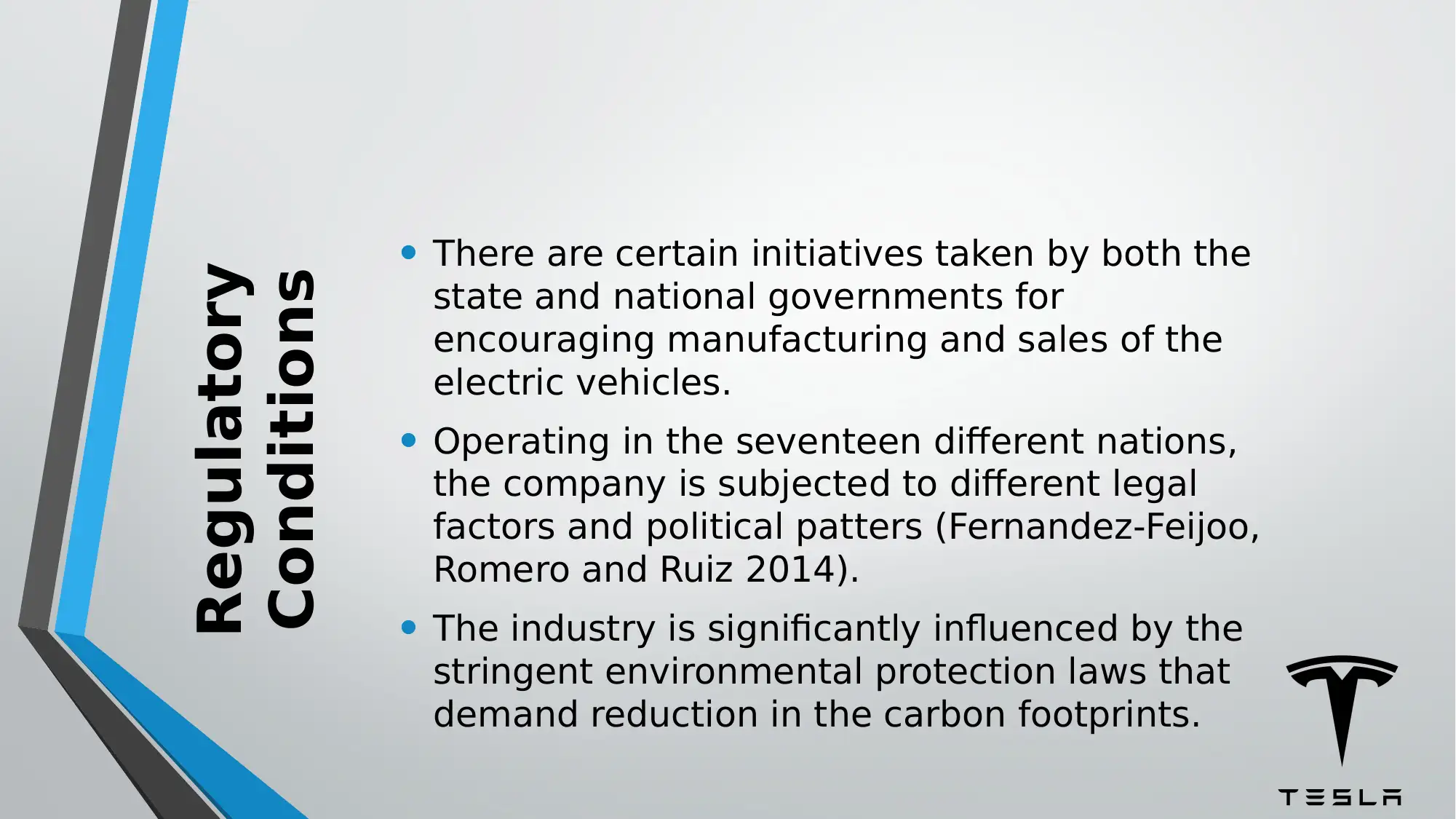
• There are certain initiatives taken by both the
state and national governments for
encouraging manufacturing and sales of the
electric vehicles.
• Operating in the seventeen different nations,
the company is subjected to different legal
factors and political patters (Fernandez-Feijoo,
Romero and Ruiz 2014).
• The industry is significantly influenced by the
stringent environmental protection laws that
demand reduction in the carbon footprints.
Regulatory
Conditions
state and national governments for
encouraging manufacturing and sales of the
electric vehicles.
• Operating in the seventeen different nations,
the company is subjected to different legal
factors and political patters (Fernandez-Feijoo,
Romero and Ruiz 2014).
• The industry is significantly influenced by the
stringent environmental protection laws that
demand reduction in the carbon footprints.
Regulatory
Conditions
Paraphrase This Document
Need a fresh take? Get an instant paraphrase of this document with our AI Paraphraser
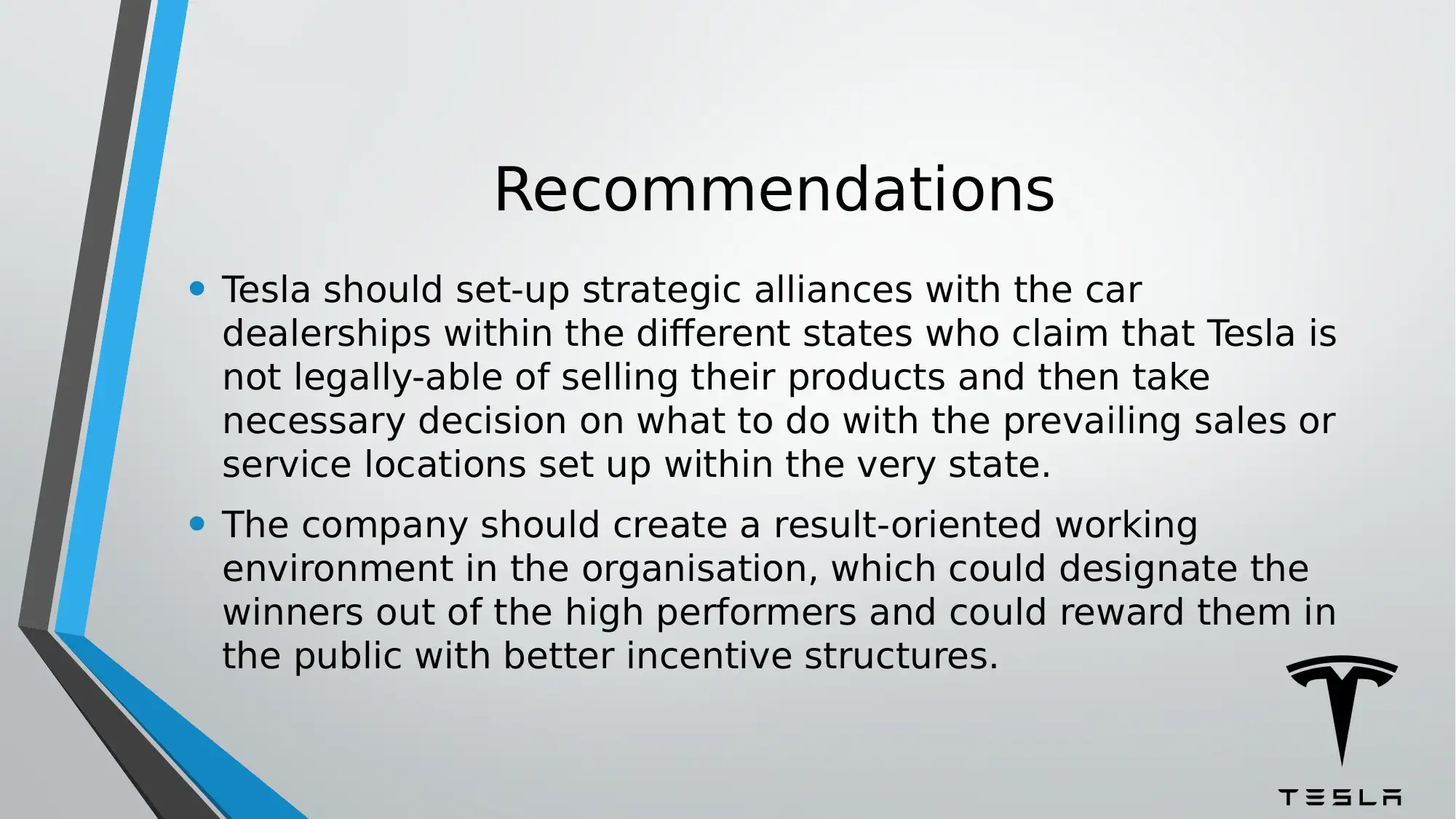
Recommendations
• Tesla should set-up strategic alliances with the car
dealerships within the different states who claim that Tesla is
not legally-able of selling their products and then take
necessary decision on what to do with the prevailing sales or
service locations set up within the very state.
• The company should create a result-oriented working
environment in the organisation, which could designate the
winners out of the high performers and could reward them in
the public with better incentive structures.
• Tesla should set-up strategic alliances with the car
dealerships within the different states who claim that Tesla is
not legally-able of selling their products and then take
necessary decision on what to do with the prevailing sales or
service locations set up within the very state.
• The company should create a result-oriented working
environment in the organisation, which could designate the
winners out of the high performers and could reward them in
the public with better incentive structures.
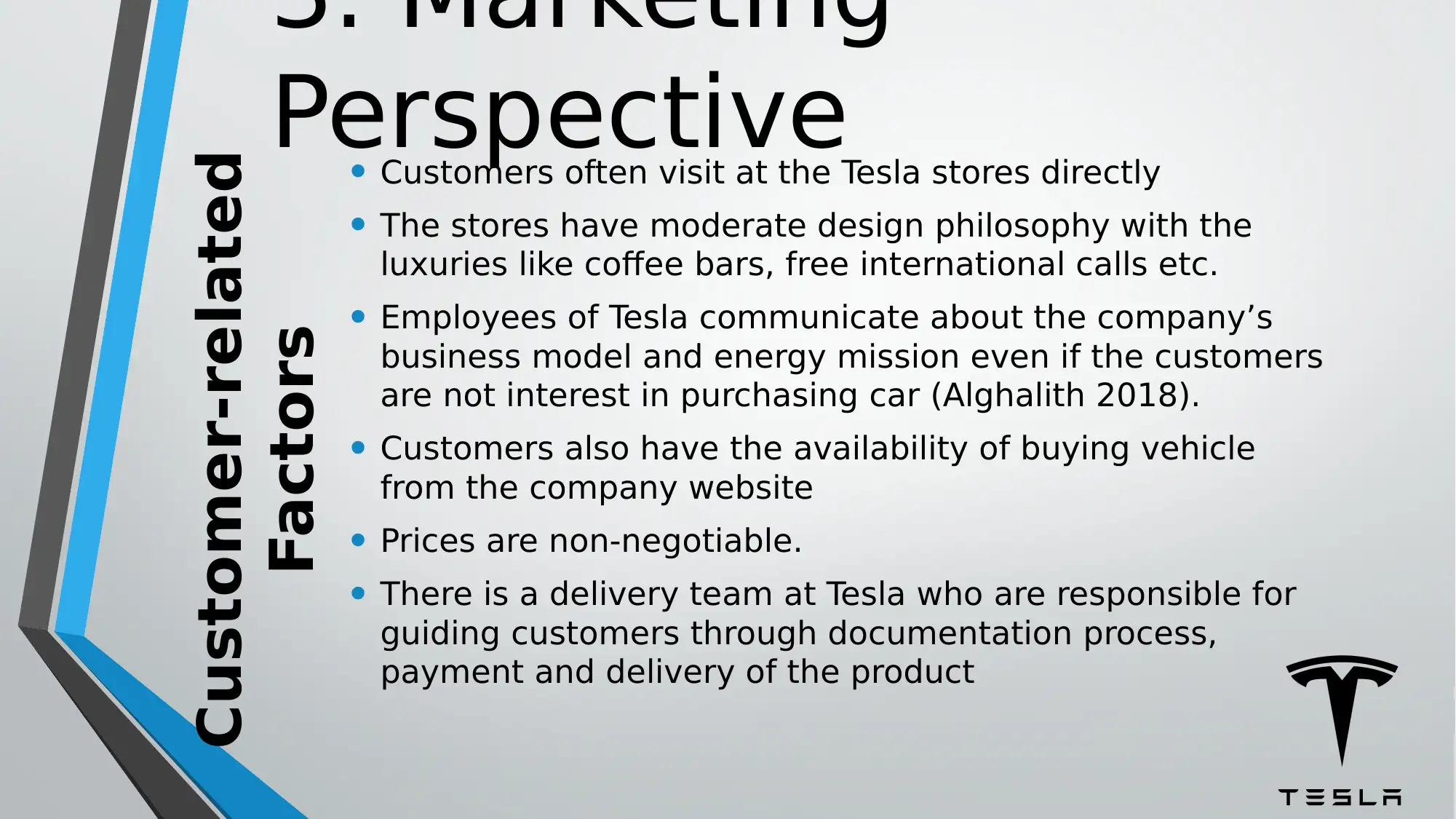
3. Marketing
Perspective• Customers often visit at the Tesla stores directly
• The stores have moderate design philosophy with the
luxuries like coffee bars, free international calls etc.
• Employees of Tesla communicate about the company’s
business model and energy mission even if the customers
are not interest in purchasing car (Alghalith 2018).
• Customers also have the availability of buying vehicle
from the company website
• Prices are non-negotiable.
• There is a delivery team at Tesla who are responsible for
guiding customers through documentation process,
payment and delivery of the product
Customer-related
Factors
Perspective• Customers often visit at the Tesla stores directly
• The stores have moderate design philosophy with the
luxuries like coffee bars, free international calls etc.
• Employees of Tesla communicate about the company’s
business model and energy mission even if the customers
are not interest in purchasing car (Alghalith 2018).
• Customers also have the availability of buying vehicle
from the company website
• Prices are non-negotiable.
• There is a delivery team at Tesla who are responsible for
guiding customers through documentation process,
payment and delivery of the product
Customer-related
Factors
⊘ This is a preview!⊘
Do you want full access?
Subscribe today to unlock all pages.

Trusted by 1+ million students worldwide
1 out of 23
Related Documents
Your All-in-One AI-Powered Toolkit for Academic Success.
+13062052269
info@desklib.com
Available 24*7 on WhatsApp / Email
![[object Object]](/_next/static/media/star-bottom.7253800d.svg)
Unlock your academic potential
Copyright © 2020–2025 A2Z Services. All Rights Reserved. Developed and managed by ZUCOL.




